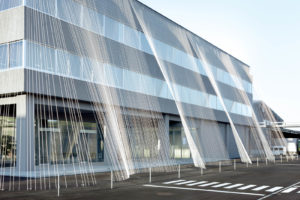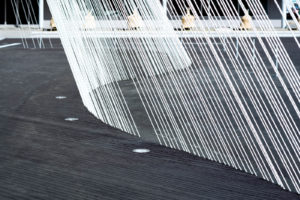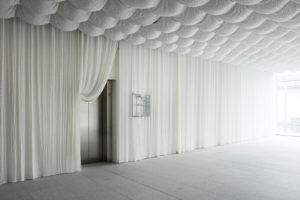
A Japanese fabric manufacturer reinforces its showroom against future earthquakes, making a provocative visual statement.
With the four main islands of Japan perched atop a convergence of three major tectonic plate boundaries, the country has a history of earthquakes and seismic activity. The ongoing seismic impact on buildings, infrastructure and population is significant, requiring some of the most advanced engineering design for construction and building in the world.
The Fabric Laboratory—or “Fa-bo” building—is a recently completed textile exhibition and information center that has a surprising solution for seismic reinforcement. Most structures located within active or high-risk seismic zones require elaborate movement connections at all joints and a foundation that can accommodate lateral (horizontal) movements without disconnecting the superstructure from the footings. These requirements allow a building to slide back and forth without falling down.
With standard rigid frame construction, whether steel or reinforced concrete framing, a typical seismic reinforcement strategy is to add stiffening elements, such as cross bracing, within the center core of a building and at key structural corners. This practice provides resistance to the sway created by the earth movements of an earthquake.
Textiles in action

The Fa-bo building is a renovation of Komatsu Seiren’s former head office, a three-story reinforced concrete structure located in Nomi, not far from the textile company’s current headquarters. Komatsu Seiren, a leading fabric manufacturer, is located on the northwest coast of Honshu, Japan’s largest island, in the Ishikawa Prefecture. The company specializes in large production dyeing of polyester and nylon used for woven and knitted fashion fabrics. Komatsu Seiren also produces coatings for fibers and fabrics used in fashion and sports clothing, building interiors, automotive interiors, and medical and electrical materials that require special technical coatings.
Considering all of Komatsu Seiren’s manufacturing capabilities, Tokyo-based Kengo Kuma & Associates (KKAA) found ways to incorporate these materials in the renovation. The textile manufacturer asked KKAA’s internationally renowned Kengo Kuma to transform the structure’s interior and exterior into a museum, making it a “space to display the technology of Komatsu Seiren.” Kuma, who holds a professorship at the Graduate School of Architecture, University of Tokyo, is frequently compared to compatriots Shigeru Ban and Kazuyo Sejima as “one of the most significant Japanese figures in contemporary architecture,” according to the international architecture blog Arch Daily. His architectural influences include the American architects Frank Lloyd Wright and Louis Kahn, and his designs incorporate strong affinities for light, transparency and materiality. KKAA recently announced plans for the Hans Christian Andersen Museum in Odense, Denmark, and Kuma’s first skyscraper in North America, a mixed-use luxury tower, is to be built next to Stanley Park in Vancouver, Canada.

A strong demonstration
The project brief for the Fa-bo building included a request to utilize a product that Komatsu Seiren began developing in 2010 called Cabkoma Strand Rod. The product is a thermoplastic carbon fiber (CF) composite that has been tested to be seven times stronger than an equivalent diameter iron rod but is much lighter in weight. Cabkoma uses carbon fiber for an inner layer, is covered with an outer layer of synthetic fiber and inorganic fiber, and is then impregnated with a thermoplastic resin.
The composite assembly (or CF rod) has high tensile strength with exceptional flexibility and lightness, which the manufacturer claims is the lightest seismic reinforcement in the world. Its use in the Fa-bo showroom marks it as the world’s first structure in which a CF composite strand is used for seismic reinforcement.
Innovation from craft traditions
The composition of the Cabkoma rod was inspired by a technique of braiding ropes found in the Komatsu region of Japan, and was developed with support from the Ishikawa Prefectural Government funds for creating next-generation industries. Since 2012, the Cabkoma project has received a subsidy for advanced technology demonstration and evaluation facility development from Japan’s Ministry of Economy, Trade and Industry.
All technical fibers are strong in tension, so an ideal application would dramatically showcase this quality. This is exactly what Kuma has done by “draping” the thermoplastic CF composite rods (or cables) on the exterior of the building. The strands are secured at the top of a central gathering node fixed to the centrally located elevator machine-room penthouse. The bottom ends of the strands are anchored in the ground outside the main floor on three sides of the building. (The fourth side of the building is enclosed by a warehouse and does not need as much seismic reinforcing.) Rather than simply pulling the cables taut in an even curving arc around the base of the building, Kuma has added interest to the draping by undulating the edge and holding sections of the strands apart at ground level to create open access to the building entrance.

Inner and outer force
Fa-bo uses both internal cross-bracing (utilizing CF rod assemblies at more than 20 places internally on the middle and upper floors) and exterior-draped fibers to achieve the stabilization needed. The internal cross-bracing locations are partition brace-bearing walls strategically located to reinforce the existing building frame. The CF rods are arranged in a diagonal mesh pattern set within rectangular floor-to-ceiling-high steel frames that fit exactly within and are fastened to the building’s existing structural frame. The two systems must work together in order to dampen any seismic impact on the structural frame; without the internal brace-bearing walls, the exterior cable bracing would cause the building’s structural frame to compress, risking collapse or compression of the floors in the event of an earthquake.
KKAA followed the engineering target values of approximately 10 percent reinforcement for the structure using CF rod partition brace-bearing walls—and achieved an additional 3 percent reinforcement by using the exterior CF rods. Care was taken not to negatively impact the existing structure during the study and evaluation of the seismic strength of the reinforcements. Carbon fibers are more commonly used in the transportation industries (aeronautics, automobiles, trains) and furniture industries (exterior street furniture, custom high-end furniture). However, carbon fiber applications are becoming more common in the architectural industry.
Full product integration
In addition to the application of seismic reinforcements that use the CF rods, Komatsu Seiren operates an advanced materials center that produces eco-friendly materials such as carbon fibers and an ultra-foam ceramic building material called Greenbiz®, an ultrafine porous spongy ceramic base used in green roof applications. KKAA used Greenbiz and other Komatsu Seiren products to capitalize on the potential of their light, yet soft, fiber qualities. Translucent, billowy fabrics from the company’s fashion lines were used inside the building to envelope the display and exhibit areas, repeating the “draping” theme of the overall building.
Bruce N. Wright, AIA, is a consultant to designers and architects and a frequent contributor to Fabric Architecture, Specialty Fabrics Review and Advanced Textiles Source.
 TEXTILES.ORG
TEXTILES.ORG


